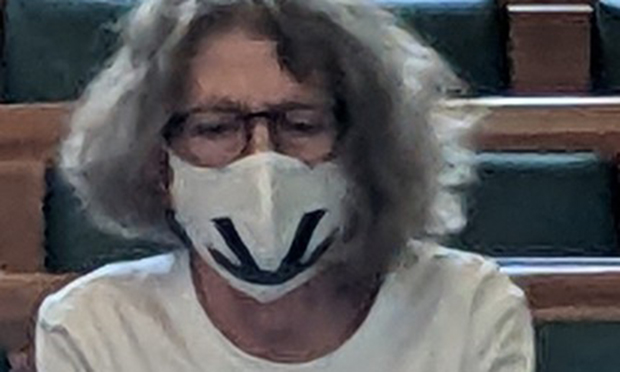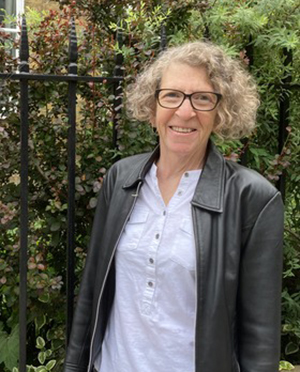Anti-LTN campaigner stages silent protest after being told her question about air quality would not be considered at health meeting

Clair Battaglino stages protest at the health board. Photograph: Julia Gregory
A campaigner has staged a silent protest with tape over her mouth after she was told a health meeting would not answer her questions about air quality on roads affected by low traffic neighbourhoods (LTNs).
Clair Battaglino, who stood as an independent in May’s local elections, claimed people’s concerns were being “stifled” when she was told her question would not be considered at Hackney’s health and wellbeing board.
The long-standing critic of LTNs said she thought concerns over displaced pollution would fit into the topic of climate action and health. Her question will instead be dealt with at cabinet in October.
She was told by the council: “Cabinet is an executive function of the council and the most appropriate place to respond to your question relating to LTNs. ”
Health and wellbeing board co-chair Dr Stephanie Coughlin said it would review whether Battaglino’s question should be discussed at its meeting and respond in 10 days.
LTNs were introduced to cut the amount of traffic and pollution in the borough.
Hackney is in the top ten boroughs in the UK for deaths from air pollution, Rebecca Waters from the net zero programme at East London Health and Care Partnership told the board.
Battaglino, who started using an inhaler two months after LTNs came in, said her lung capacity has decreased by 20 points.
She wants to know about the monitoring of the health impacts of LTNs, particularly on children attending nurseries and schools on boundary roads.
She said: “I have seen rises in congestion, increases in pollution, greater numbers of road accidents and have heard many stories of increased usage of inhalers and have experienced a decline in my own lung health.”

Battaglino stood as an independent in May’s local elections. Photograph: Independent Network
Battaglino said two other residents have also been told their questions about the impact of pollution would be considered at another meeting.
One of them said they were prescribed a second inhaler since LTNs were introduced and wanted to know “what measures local health practitioners, and more generally the NHS, have been taking to monitor, research and address the harmful respiratory health impacts of pollution over the past two years with respect to those living, working or going to school on roads now receiving high volumes of relocated traffic”.
Hackney Council said there was a 38 per cent drop in traffic at its four biggest LTNs, with a two per cent drop on boundary roads. It said the total number of cars has dropped by 56 per cent inside LTNs, and by five per cent on boundary roads.
It said the schemes have also helped to cut air pollution: “Across all LTNs and surrounding areas, there are reductions in nitrogen dioxide at 329 of 388 locations.”
The Town Hall said the restrictions have helped people change their behaviour and switch to “active travel”, including walking, running and cycling.
Researchers from University College London, Imperial College London and the University of the West of England are looking into the impacts of low traffic neighbourhoods in the UK.
A council spokesman said: “Ms Battaglino’s question referred to the role of health practitioners – not the function of the board. In advance of the meeting, we advised that this would be better asked of the NHS directly as Ms Battaglino’s initial question was only directed to NHS practitioners on the board.
“The board also suggested to Ms Battaglino that her amended question could be submitted to the council’s next cabinet meeting as it is an executive function of the council, and the most appropriate body to respond to her question.”
He added: “Across our four biggest LTNs, there were fewer vehicle journeys overall inside the LTNs and on boundary roads – showing the clear potential for LTNs to help reduce carbon emissions.
“Publicly available air quality monitoring data on our website shows improvement in nitrogen dioxide pollution levels across the borough in 2021, compared to pre-pandemic levels, which coincides with the introduction of London Fields, Hackney Downs, Hoxton West and Homerton LTNs.”
